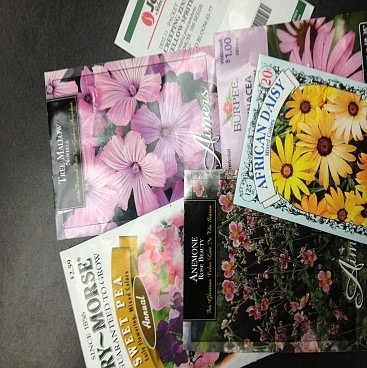The basics of reading seed packets
Stores are stocking 2021 flower and vegetable seeds now for planting this year, and the packets contain quite a bit of useful information to help you be successful in growing them. So, here’s an overview of what to look for.
First, look at the front of a seed packet, where many of them provide a picture of the plant and give its common name as well as its Latin name, and a brief description of it, often letting you know if it’s easy to grow. If the Latin name is not given, be aware that there may be several different plants that go by that same common name, but may not be exactly what you were hoping to grow.
Either on the front of the packet or the back, flower packets will tell you if they are sun lovers or if they do better grown in partial shade. They indicate whether they’re annuals, which means they’ll grow profusely for only one season, or they’re perennials, which means they will continue to grow year after year. So, if you’re looking for a spot of color in your front border and decide to grow some marigolds, which are annuals, you will need to replant them each year. You’ll also see on the front of seed packets the weight of the seeds inside the packet, for example 750 g (grams) or 300 mg (milligrams), and occasionally the number of seeds to a packet, which helps you know if one packet is enough for the area you want to plant.
Then look at the back side of the seed packet where you’ll find a description of the plant, its height when fully grown, the number of days it takes to germinate the seeds, the number of days until it blooms or is ready to harvest, how deep to plant the seeds and how far apart to space them. It may also include thinning tips once the plant has reached a certain height to ensure each plant has optimal room to grow.
Some packets also give special growing tips and tell you whether to sow the seeds directly in the ground outdoors or start them indoors in containers a certain number of weeks before the last spring frost, or let you choose either option. May 1 is our average last spring frost date in the Columbia Basin, according to the WSU Extension Office. So simply count the weeks listed on the seed packet back from May 1, and you’ll know the optimal time to start your seeds from a specific packet indoors. Not often listed is the first frost date, which tells you how long some plants will survive during a growing season into the fall. Oct. 16 is the average date for this area. Keep in mind that frost dates are mean freeze dates. This means there is a 50% chance of a freeze on that date. It is not a guarantee, but only an assessment of probability.
Here are some other terms that you may find on a seed packet (excerpted from a WSU Extension Office fact sheet:
Heirloom: These seeds produce varieties that have been around for 50 years or more, even centuries. They are open-pollinated, which means by wind or insects. They generally have characteristics that are stable and reliably reproduce similar plants the following year. So, if you harvest your seeds from your heirlooms, you can replant them the next year and get similar results, as long as cross-pollination is prevented. Cross-pollination may occur if you plant different heirloom varieties of the same plant, say corn, near one another, or your next door neighbor has planted a different heirloom variety from yours.
Crops that normally cross-pollinate include all members of the Brassica family: cabbage, broccoli, mustards, collards, kale, kohlrabi, cauliflower, turnips, radishes, and Brussels sprouts; the cucurbit family: zucchini and other summer squash, winter squash, pumpkins, cucumbers, and melons; carrots, parsnips, beets, chard, spinach, and corn.
Hybrids: These are created by careful cross-pollination of two different varieties, with each possessing desirable characteristics. Unlike heirlooms, seeds from hybrids rarely produce like the parents, so they are not suitable for saving. They are often tough, vigorous, uniform and productive plants. The traits of vegetable hybrids are important to commercial growers because they are bred for uniform time of maturity, ability to withstand machine harvest and good post-harvest storage.
Taste may not be the highest priority with these plants. Often hybrids have the designation “F1” with their name. If the seed packet doesn’t indicate that it’s a hybrid, you can assume it’s open pollinated.
Don’t forget to look at the date stamped on each seed packet; for example, “USA 12/20,” which means it was packaged in the U.S. in December for the 2020 season. For the best germination success rate, use seeds that were prepared for the current year.
For answers to gardening questions, contact the WSU Grant-Adams Master Gardeners via email at ga.mgvolunteers@wsu.edu or visit extension.wsu.edu.grant/gardening.



